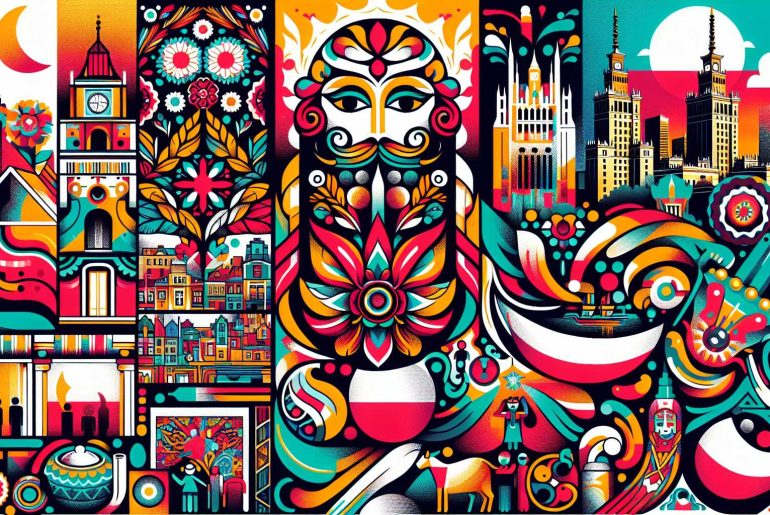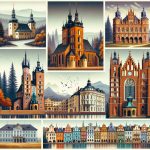
Poland’s art scene is a fascinating mix of old and new. It has a long history that shapes its artistic traditions, but it’s also home to cutting-edge movements that push the limits of what art can be. Across the country, galleries and art spaces not only celebrate Poland’s artistic past but also support the creation of new works.
These places highlight artists whose creations are appreciated worldwide, not just in Poland. The art festivals and events throughout the year add even more excitement, showing just how much creativity there is to discover in Poland’s lively art world.
Historical Roots of Polish Art
Polish art has a long history that starts in the medieval period and is closely linked to the country’s cultural and political developments. During this early time, Polish artists were known for their Gothic architecture and Christian-themed works, seen in many cathedrals and churches across the country. These buildings often featured intricate sculptures and frescoes, showcasing the skill and creativity of their makers.
As time went on, Poland entered the Renaissance, a period known for its emphasis on humanism and innovation in art. This era was a turning point for Polish art, as artists started incorporating ideas from the Italian Renaissance while still maintaining a style that was distinctly Polish. This blend of influences helped Polish art to stand out and reflected the country’s identity and strength during times of change.
For example, the Wawel Castle in Krakow is a prime example of this period, where Renaissance architecture blends seamlessly with Polish elements, creating a landmark that is rich in history and beauty. This castle, among others, serves as a concrete example of how Poland’s art scene evolved, showing the impact of different artistic movements and the country’s resilience.
The Avant-Garde Movement
Poland played a significant role in the Avant-Garde Movement, a time of creative exploration and bold innovation in art. This period was notable not just in Poland but across Europe, as artists sought new ways to express themselves. Polish artists, however, added their unique touch to these European trends, blending them with local themes and concerns. They ventured into various art styles such as abstract art, constructivism, and surrealism. But it wasn’t just about the art. These movements also carried deep messages about freedom, identity, and what the future could hold.
The Avant-Garde Movement in Poland was diverse. Artists didn’t stick to one style or vision; instead, they explored a wide range of ideas and techniques, creating a rich and varied art scene. This diversity meant that the movement wasn’t just a single trend but a collection of many different approaches to art and expression. This period was crucial for setting the stage for future artists, influencing the direction of Poland’s art scene for years to come.
For example, the work of Władysław Strzemiński, a key figure in Polish avant-garde art, illustrates this period’s innovation. He co-founded the first avant-garde art group in Poland, ‘a.r.’ group, which was instrumental in promoting new art forms like Unism, emphasizing the unity between the form and the content of art. His contributions, along with those of his contemporaries, underscored the avant-garde’s impact on shaping modern Polish art.
What made the Avant-Garde Movement special was not just the new styles of art that emerged but the spirit behind it. Artists were driven by a desire to break free from traditional constraints and explore the possibilities of what art could be. This wasn’t a straightforward path; it involved a lot of experimentation and, at times, controversy. But it was this willingness to push boundaries and explore new ideas that fueled the movement’s energy and creativity.
Contemporary Galleries and Spaces
In recent years, Poland has seen an impressive growth in contemporary galleries and spaces. These venues have become key in presenting modern art and encouraging discussions among artists, critics, and art enthusiasts. Far from being just places where art is hung on walls, these galleries act as vital cultural hubs. They are where new artistic ideas and forms are developed and introduced to both the national and international art scenes.
These contemporary spaces play a multifaceted role. Beyond showcasing art, they are deeply involved in creating educational experiences through seminars, workshops, and artist talks. This makes them important centers for learning and exchange within the global contemporary art community. Through these activities, they contribute immensely to the vibrancy and variety of Poland’s art scene, ensuring it remains relevant and dynamic.
For example, galleries like Ujazdowski Castle Centre for Contemporary Art in Warsaw not only exhibit a wide range of contemporary art but also host residencies for artists and curators. This fosters a creative environment where new ideas can flourish. Similarly, WRO Art Center in Wroclaw focuses on media art, offering a platform for artists working with new technologies and interactive media. These examples show how these spaces actively shape the art landscape by supporting innovative practices.
Celebrated Polish Artists
Several Polish artists have made a significant impact on both national and global art scenes, showcasing Poland’s rich culture and innovative approaches. For instance, Tamara de Lempicka is renowned for her unique Art Deco style. She skillfully combined modern design with classical painting techniques, making her works highly recognizable and celebrated worldwide. Her paintings, characterized by sharp lines and vibrant colors, offer a fresh perspective on traditional subjects.
Magdalena Abakanowicz, on the other hand, revolutionized sculpture and fiber art. She delved into profound themes such as human existence, the behavior of crowds, and the tension between individuality and collectivity. Abakanowicz’s installations often feature large groups of figures, inviting viewers to reflect on their place in society. Her ability to use textiles in such a powerful and evocative way has opened new avenues for artists exploring similar themes.
Wilhelm Sasnal is another Polish artist who brings a contemporary lens to his work, focusing on the complexities of modern life through his paintings. Sasnal’s art captures everyday scenes and historical events with a unique perspective, making the ordinary appear extraordinary. His work encourages viewers to look closer and rethink their perceptions of the world around them.
These artists, each in their own right, have contributed to the dynamic and diverse Polish art scene. They have pushed boundaries, experimented with new mediums and themes, and in doing so, have enriched the global art landscape. Their work not only reflects Poland’s cultural heritage but also its ongoing dialogue with contemporary issues and ideas.
Art Festivals and Events
Poland is a hub for art festivals and events, drawing from its rich history of celebrated artists. These occasions range from the traditional to the avant-garde, highlighting Poland’s diverse artistic talent. They’re not just for showcasing local art; they also welcome artists from around the globe, encouraging a worldwide exchange of ideas and creativity through art. Key events include the Warsaw Autumn Festival, Krakow Photomonth, and Wroclaw Contemporary Art ECoC. These festivals do more than just display Polish art; they play a significant role in developing a modern, dynamic cultural identity for Poland that has influence far outside its borders.
Each of these festivals has its unique charm and focus. The Warsaw Autumn Festival, for example, is a haven for contemporary music lovers, bringing together composers and musicians from all over the world. Krakow Photomonth turns the city into a gallery, showcasing photographic art in various locations, from traditional museums to unexpected spaces. Wroclaw Contemporary Art ECoC, on the other hand, pushes the boundaries of contemporary art, offering a platform for experimental and innovative projects. These events not only celebrate artistic achievements but also stimulate dialogue and understanding across cultures.
Conclusion
Poland’s art scene is truly diverse, mixing old, new, and cutting-edge elements. It has a rich history that provides a great foundation for artists, allowing them to create and experiment freely.
You’ll find all sorts of art in Poland, from galleries and exhibition spaces to festivals that celebrate both the traditional and the modern. This mix gives us a closer look at how Poland sees its culture and society, making it an important player on the world’s art stage.
Poland stands out by combining its historical roots with fresh, innovative ideas.







Comments are closed.